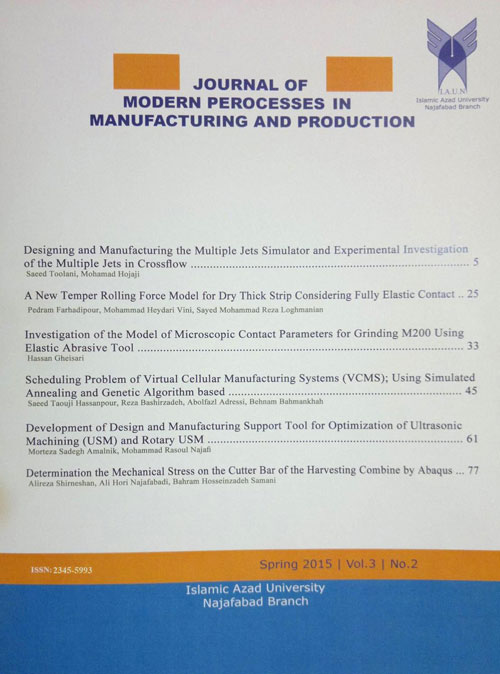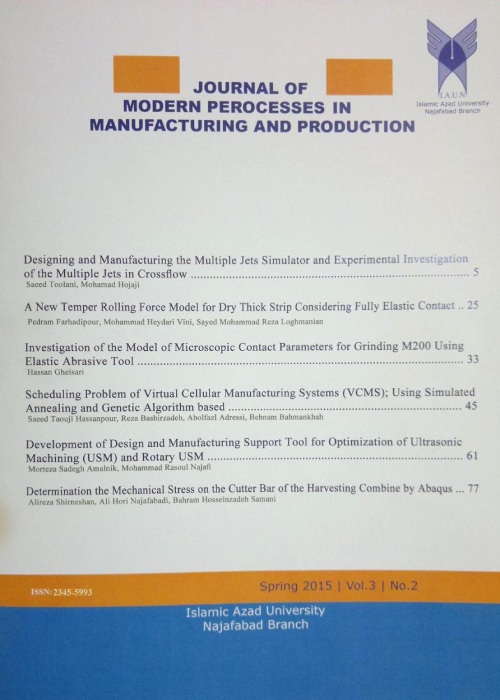فهرست مطالب

Journal of Modern Processes in Manufacturing and Production
Volume:5 Issue: 2, Spring 2016
- تاریخ انتشار: 1395/05/10
- تعداد عناوین: 6
-
Pages 5-11Magnesium is potentially useful for orthopedic and cardiovascular applications. Magnesium and its alloys are light, biodegradable, biocompatible metals that have promising applications as biomaterials. However, the corrosion rate of this metal is so high that its degradation occurs before the end of the healing process. One of the ways to improve the corrosion rate is to compose it with ceramic materials such as HA, TCP and so on. In this study, at first, the alloy with a nominal composition of Mg-3%Al-1%Zn (AZ31 alloy) was produced by high energy ball milling (HEBM) of Mg powder, Zn powder and Al powder under high purity argon. The ball milling parameters were chosen as following: shaft rotation was 600 rpm, ratio of balls to powder was 10:1 and milling time was 90, 180, 270 and 360 min under argon atmosphere. The obtained Mg alloy powders were pressed with different amounts of HA-Zeolite (HZ) powder mixture, weight ratio HA (Hydroxyapatite) to Zeolite 4:1, under 1000 MPa in steel die with 12 mm in diameter and 20 mm in height. The pressed samples were sintered for 1 h at 630 K in an inert atmosphere furnace. Microstructure characterization of as-milled powders and as-sintered alloys were carried out by SEM. An X-ray diffraction (XRD) was used for phase analysis. XRD patterns of the powders mixture showed that the AZ31 alloy powder has been gained after 270 min.Keywords: AZ31, HA, Zeolite, Mechanical Alloying, Powder Metallurgy, Bio Composite
-
Pages 13-20The electro discharge machining (EDM), one of the methods used in the machining industry and a non-traditional manufacturing method, the electro erosion process does not depend on the hardness of material and offers a way to process materials of very complex geometry with very fine and high precision by using cheap electrode materials, which make it a preferred method. In this study, effect of wet and near dry EDM has been investigated. Design of the experiment was chosen as full-factorial. Experimental data has been statistically analyzed and then appropriate model was extracted. The experimental results show that surface roughness decreases by increase of peak current and also pulse on-time; it should be mentioned that effect of peak current on surface roughness is greater than pulse on-time. Also by using near dry machining (NDM), surface roughness decreased about 1µm and approximately 15 percent. These indicate the good performance of NDM.Keywords: Electro discharge machining, Deionized water, Surface Roughness
-
Pages 21-31In this paper, a three-dimensional finite element model has been developed to simulate the laser-TIG hybrid welding (HLAW) of stainless steel 1.4418 with thickness of 4 mm. Transient temperature profile and dimensions of the fusion zone and heat affected zone (HAZ) during welding process are calculatedusing finite element method (FEM) and were solved in the ABAQUS/Standard software.The heat source model is a combination of Goldak distribution for the arc heat flux, a body Gaussian distribution for laser heat flux and a surface heat flux model. The DFLUX subroutine was used for implementation of the movable welding heat sources of the models.To validate the model, several HLAWexperiments were performed with a pulsed Nd:YAG laser and TIGsources. Good agreement between the simulated and the experimental measurements revealed that the model would be appropriate forHLAWnumericalsimulation. Among the material properties, the material conductivity is the most important term which influences on the weld bed dimensions.Keywords: Laser, TIG Hybrid Welding, Temperature Field, FEM, Simulation, Nd:YAG Laser, Heat Source Model
-
Experimental Investigation of the Surface Roughness in Grinding of BK7 Optical Glass in Brittle ModePages 33-41Surface roughness is a significant parameter which determines the efficiency of optical components. Surface damages induced by grinding strongly influence the mechanical strength and optical quality of optical glasses. It is meaningful to rapid evaluate the surface roughness through the measurement of different grinding parameters. In this study, a cup diamond wheel (D64) is used in grinding process of the specimens made of BK7optical glass to investigate the influences of grinding parameters on the surface roughness. The grinding parameters used in this study are depth of cut, cutting speed, tables speed and feed rate; and effects of these parameters are studied. The dependence of surface roughness on grinding parameters was systematically analyzed. The experimental results indicate that feed rate, depth of cut and cutting speed have the most significant effect on surface roughness, respectively. By increasing feed rate and depth of cut, the surface roughness increases and increasing cutting speed results in a decrease in surface roughness.Keywords: Grinding, Cup Diamond Wheel, Optical Glass BK7, Surface Roughness
-
Pages 43-53The abrasion is a significant issue, especially in machining of rigid steels. A functional and suitable approach for enhancing the heat transfer from machining area is using an intermediate fluid with higher heat transfer potential instead of common fluids. The objective of this experimental study is to discuss production, stability and thermal conductivity examination of water/graphene oxide nanofluid considered as a new nanofluid used in machining process instead of common coolant. In this research, for thermal conductivity enhancement of a basic fluid (Deionized water), a nanofluid development method composed of two steps as well as particles of nano dimension consisting water/graphene oxide is used. Producing 16 different nanofluid samples, the sample having a higher stability than others is considered for examining the thermal conductivity. The Zeta potential measurement is used in order to precisely determine stability of the final sample of water/graphene oxide nanofluid. Considering the obtained results, a highly acceptable level of stability is concluded. In addition, the transient hot wire method as well as thermal analyzer system is used to measure the heat transfer coefficient of water/graphene oxide nanofluid. According to the obtained results, the thermal conductivity of water/graphene oxide nanofluid in most states has increased to 71% compared to the base fluid. It is also observed that water/graphene oxide nanofluid has a high heat transfer potential. Utilizing this nanofluid enhances the heat transfer, improves the surface quality and reduces the damages caused by machining instrument.Keywords: experimental study, Machining Process, Nanofluid, Thermal Conductivity
-
Pages 55-67This paper addresses the problem of the fractional sliding mode control (FSMC) for a MEMS optical switch. The proposed scheme utilizes a fractional sliding surface to describe dynamic behavior of the system in the sliding mode stage. After a comparison with the classical integer-order counterpart, it is seen that the control system with the proposed sliding surface displays better transient performance. The claims are justified through a set of simulations and the results obtained are found promising. Overall, the contribution of this paper is to demonstrate that the response of the system under control is significantly better for the fractional-order differentiation exploited in the sliding surface design stage than that for the classical integer-order one, under the same conditions.Keywords: Fractional Order Control, Sliding mode, Micro, Electro Mechanical Systems (MEMS), Lyapunov Stability, Robust Control


